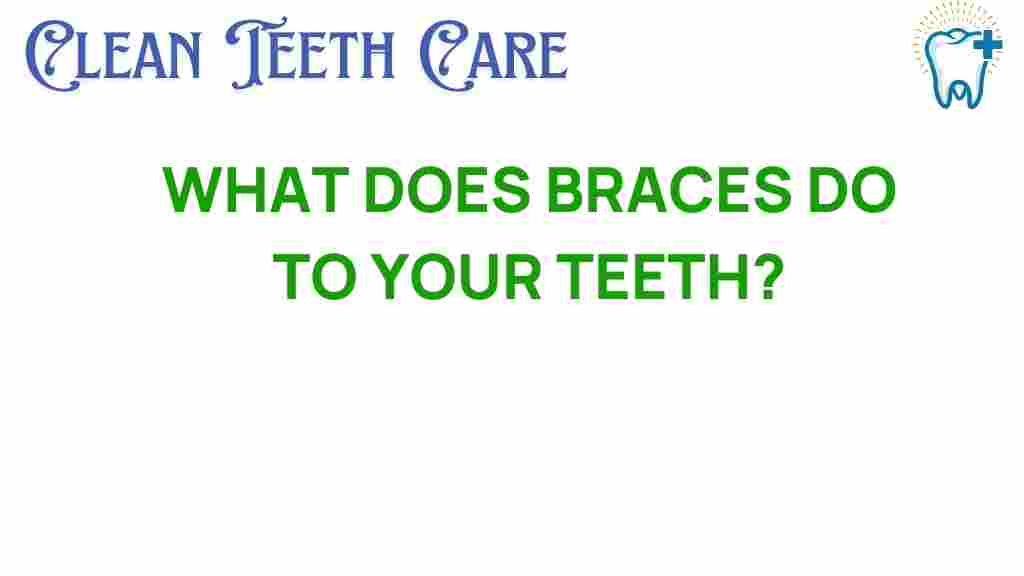Unlocking the Mystery: What Braces Do to Your Teeth
Are you considering braces for yourself or your child? Understanding what braces do to your teeth is essential for anyone embarking on the journey of orthodontics. This article will provide an in-depth look at how braces work, their impact on dental health, and the transformative effects they have on your smile. From bite correction to teeth straightening, we will explore the entire process involved in this common dental treatment.
Understanding Braces and Their Function
Braces are orthodontic devices designed to correct misaligned teeth and jaws. They function by applying continuous pressure over time to gradually shift teeth into the desired position. This process involves several components:
- Brackets: Small squares bonded to each tooth that hold the archwire in place.
- Archwire: A thin metal wire that connects the brackets and helps guide the teeth into alignment.
- Ligatures: Tiny rubber bands that hold the archwire to the brackets.
- Bands: Metal rings that fit around the back teeth to provide additional support.
By using these components, braces create the necessary force to reposition teeth gradually, which can lead to a significant smile transformation.
The Benefits of Braces for Dental Health
Braces are not just about aesthetics; they play a crucial role in improving your overall dental health. Here are some benefits:
- Improved Alignment: Correctly aligned teeth are easier to clean, reducing the risk of cavities and gum disease.
- Bite Correction: Braces can address bite issues, such as overbites, underbites, and crossbites, leading to better oral function.
- Enhanced Oral Care: With straighter teeth, maintaining proper oral hygiene becomes much simpler.
- Boosted Confidence: A straight smile can significantly enhance self-esteem and social interactions.
The Process of Teeth Straightening with Braces
Embarking on orthodontic treatment involves several steps. Here’s a detailed breakdown of the process:
1. Initial Consultation
The journey begins with a visit to an orthodontist. During this consultation, the orthodontist will:
- Examine your teeth and bite.
- Discuss your dental health history.
- Take X-rays and impressions of your teeth.
- Develop a personalized treatment plan.
2. Fitting the Braces
Once the treatment plan is established, the orthodontist will fit your braces. This involves:
- Cleaning and drying your teeth.
- Bonding brackets to each tooth.
- Inserting the archwire and securing it with ligatures.
3. Regular Adjustments
Throughout the treatment period, usually lasting 1-3 years, you will have regular appointments to adjust the braces. This is essential for:
- Monitoring progress.
- Changing wires to continue the movement of teeth.
- Making any necessary adjustments to ensure effective treatment.
4. Retainers
After the braces are removed, retainers will be provided to maintain the new position of your teeth. This step is crucial for preventing teeth from shifting back to their original positions.
Common Issues and Troubleshooting Tips
While braces are effective, you may encounter some challenges during your treatment. Here are a few common issues and their solutions:
1. Discomfort and Soreness
It’s normal to experience some discomfort, especially after adjustments. Here’s how to manage it:
- Use over-the-counter pain relief medication.
- Eat soft foods for the first few days after getting braces or adjustments.
- Rinse with warm salt water to soothe irritation.
2. Broken Brackets or Wires
If a bracket breaks or a wire becomes loose, contact your orthodontist immediately. In the meantime:
- Use orthodontic wax to cover any sharp edges.
- Avoid hard or sticky foods that could worsen the situation.
3. Difficulty Cleaning Teeth
Braces can make oral care challenging. To maintain optimal dental health:
- Use an interdental brush to clean between the brackets.
- Floss regularly with a floss threader.
- Consider using an electric toothbrush for better cleaning efficiency.
The Long-Term Impact of Braces on Your Smile
Many patients wonder about the long-term effects of braces. Here’s what to expect:
- Improved Confidence: A straight smile can enhance self-image and social interactions.
- Better Oral Function: Proper alignment can improve chewing and speaking abilities.
- Preventive Care: Correcting alignment can prevent future dental issues, saving money on dental treatments.
Braces are a significant investment in your dental health, and the results can be life-changing.
Conclusion: Embrace the Journey to a Healthier Smile
Braces are a powerful tool in orthodontics, promoting dental health through effective teeth straightening and bite correction. While the journey requires patience and commitment, the transformative results are worth it. From improved alignment to enhanced oral care, braces can lead to a stunning smile transformation.
If you’re ready to take the next step toward better dental health and a beautiful smile, consult with an orthodontist today. Remember, the journey to a healthier smile is a marathon, not a sprint. For more information about braces and orthodontic treatment, check out this comprehensive guide.
For ongoing support and resources regarding oral care, visit the American Dental Association for expert advice and tips.
This article is in the category Treatments and created by CleanTeethCare Team
